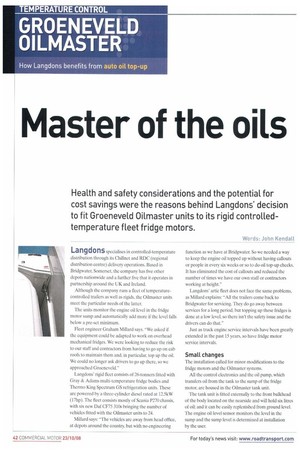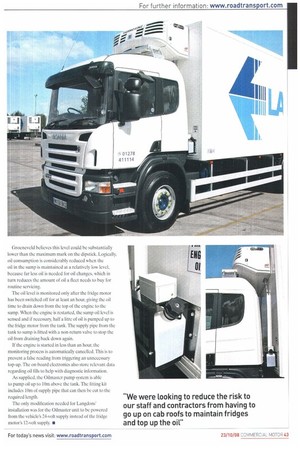Master of the oils
Page 42

Page 43

If you've noticed an error in this article please click here to report it so we can fix it.
Health and safety considerations and the potential for cost savings were the reasons behind Langdons' decision to fit Groeneveld Oilmaster units to its rigid controlledtemperature fleet fridge motors.
Words: John Kendall Langdons specialises in controlled-temperature distribution through its Chillnet and RDC (regional distribution centre) delivery operations. Based in Bridgwater, Somerset, the company has five other depots nationwide and a further five that it operates in partnership around the UK and Ireland.
Although the company runs a fleet of temperaturecontrolled trailers as well as rigjds, the Oilmaster units meet the particular needs of the latter.
The units monitor the engine oil level in the fridge motor sump and automatically add more if the level falls below a pre-set minimum.
Fleet engineer Graham Millard says. "We asked if the equipment could be adapted to work on overhead mechanical fridges. We were looking to reduce the risk to our staff and contractors from having to go up on cab roofs to maintain them and, in particular, tap up the oil. We could no longer ask drivers to go up there, so we approached Groeneveld."
Langdons' rigid fleet consists of 26-tonners fitted with Gray & Adams multi-temperature fridge bodies and Thermo King Spectrum GS refrigeration units. These are powered by a three-cylinder diesel rated at 12.5kW (17hp). The fleet consists mostly of Scania P270 chassis, with six new Daf CF75 310s bringing the number of vehicles fitted with the Oilmaster units to 24.
Millard says: "The vehicles are away from head office, at depots around the country, but with no engineering function as we have at Bridgwater. So we needed a way to keep the engine oil topped up without having callouts or people in every six weeks or so to do oil top-up checks. It has eliminated the cost of callouts and reduced the number of times we have our own staff or contractors working at height."
Langdons* artic fleet does not face the same problems, as Millard explains: "All the trailers come back to Bridgwater for servicing. They do go away between services for a long period, but topping up these fridges is done at a low level, so there isn't the safety issue and the drivers can do that."
Just as truck engine service intervals have been greatly extended in the past 15 years. so have fridge motor service intervals.
Small changes
The installation called for minor modifications to the fridge motors and the Oilmaster systems.
All the control electronics and the oil pump, which transfers oil from the tank to the sump of the fridge motor, are housed in the Oilmaster tank unit.
The tank unit is fitted externally to the front bulkhead of the body located on the nearside and will hold six litres of oil; and it can be easily replenished from ground level. The engine oil level sensor monitors the level in the sump and the sump level is determined at installation by the user. Groeneveld believes this level could be substantially lower than the maximum mark on the dipstick. Logically, oil consumption is considerably reduced when the oil in the sump is maintained at a relatively low level, because far less oil is needed for oil changes, which in turn reduces the amount of oil a fleet needs to buy for routine servicing.
The oil level is monitored only after the fridge motor has been switched off for at least an hour, giving the oil time to drain down from the top of the engine to the sump. When the engine is restarted, the sump oil level is sensed and if necessary, half a litre of oil is pumped up to the fridge motor from the tank. The supply pipe from the tank to sump is fitted with a non-return valve to stop the oil from draining back down again.
If the engine is started in less than an hour, the monitoring process is automatically cancelled. This is to prevent a false reading from triggering an unnecessary top-up. The on-board electronics also store relevant data regarding oil fills to help with diagnostic information.
As supplied, the Oilmaster pump system is able to pump oil up to 10m above the tank. The fitting kit includes 10m of supply pipe that can then be cut to the required length.
The only modification needed for Langdons' installation was for the Oilmaster unit to be powered from the vehicle's 24-volt supply instead of the fridge motor's 12-volt supply. •








































































































































































